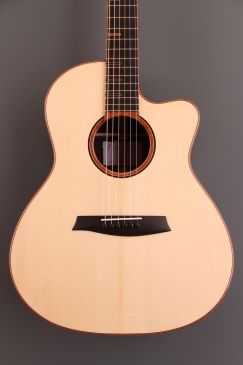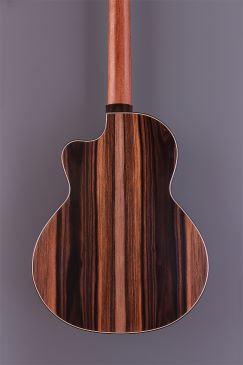Drawing on the more than 1,000-year tradition of Sicilian hand embroidery, Palermo-based luxury lifestyle brand Manima offers such exclusive, high-end products as home decor, linens, resort wear, and wearable art, all crafted using traditional techniques.
With a beautiful atelier in the city's historic center, Manima, which takes its name from Mani + Anima, meaning hands and soul, was founded by the husband-and-wife team of CEO Carolina Guthmann and Executive President Piero di Pasquale. The company focuses on combining female artisanship with technology and social impact with a platform to connect embroiderers across villages to Manima headquarters, allowing women to be included remotely while maintaining control over the quality, deadlines, and design.
Carolina recently took time out of her busy schedule to share more about Manima and the Sicilian hand-embroidery tradition.
Tell us about Manima and how it started.
It was born from the desire my husband and I had to do something meaningful in the second part of our lives, after a long and successful career in multinational corporate companies and RAI Television on my husband's side.
We left our careers, studied and researched for over a year, and then found the project that would satisfy our wish to generate social impact, work with high-end artisans, and preserve a cultural heritage. That was hand embroidery because it has a market that never dies out; it is typically female in Italy and had a very important social role in the past until globalization hit local artisanship. It is also a form of artistic handicraft that can be done in groups and even large groups; it creates strong social bonds and can be re-interpreted endlessly.
What is your background?
I have a degree in macro-economy and worked for many years in top management roles in multinational companies, such as Procter & Gamble, Bristol-Myers Squibb, and Merck.
My husband is a former TV journalist and was, among other things, an anchorman in the U.S. for RAI public TV. He has a background in political sciences and international relations and was the Director of RAI News worldwide.
What are the unique characteristics of Sicilian hand embroidery featured in your products?
Sicilian hand embroidery is rich and diverse, reflecting the island's history of 26 different conquests, each leaving its mark on local craftsmanship. This eclectic mix of influences has shaped a wide range of styles and techniques, making Sicilian embroidery truly one of a kind.
One of the standout techniques is pulled thread embroidery, a traditional Sicilian method that we incorporate in a modern and distinctive way. For instance, this technique is central to our Saline resort line, as well as our collection of colorful and vibrant table linens, giving a fresh twist to classic craftsmanship.
Moreover, throughout Sicily, many small villages have preserved and perfected unique embroidery methods over generations. We have carefully selected and partnered with some of these master artisans, integrating their extraordinary skills into our project. Their expertise ensures that each piece carries the authentic spirit of Sicilian heritage while embracing contemporary design.
When and how did the tradition of embroidery as part of a dowry originate in Sicily?
The tradition of embroidery as part of a Sicilian dowry is a reflection of the island's rich and diverse history. It evolved through centuries of cultural exchange and was a testament to the bride's skills, her family's status, and the importance of craftsmanship in Sicilian life.
This practice likely originated during the Middle Ages, influenced by the various cultures that conquered and ruled Sicily, including the Byzantines, Arabs, Normans, and Spanish, each contributing to local customs and aesthetics.
Already under Byzantine influence, Sicily saw the rise of luxurious and intricate embroidery, especially with aristocratic families, and embroidery was a way to showcase wealth and status, becoming an important element of bridal trousseaus prepared for marriage.
This further evolved under Arab influence and later in the Norman and Spanish periods. It was in later periods that embroidery flourished within Sicilian noble families and started to spread among middle-class families.
Dowries had of course also a social role as a reflection of a family's social status or as a symbolic value featuring religious or protective motifs intended to bring good fortune, fertility, and protection to the marriage.
What do the various motifs and patterns in Sicilian embroidery represent?
Apart from religious motifs like crosses, sacred hearts, and others, the rich nature in Sicily has inspired many motifs.
- Flowers and Leaves: Floral patterns are very common in Sicilian embroidery, often symbolizing beauty, fertility, and growth. Flowers like roses or pomegranates may represent love, life, and renewal.
- Wheat: Sicily has a strong agricultural tradition, and wheat is often a symbol of abundance, prosperity, and good harvests. Wheat motifs in embroidery might also evoke wishes for the family's financial success and stability.
- Olive Branches: The olive tree is a symbol of peace and longevity, as well as a representation of Sicilian heritage and the importance of agriculture.
How is the tradition of embroidery passed down through generations in Sicilian families?
In the past, embroidery was part of a girl's upbringing and traditionally regarded as an essential skill for women, particularly in rural Sicilian communities, where it was a reflection of a girl's domestic ability, patience, and creativity.
Furthermore, in some Sicilian villages, embroidery was not just confined to the family but extended to a whole community of women across generations, and many villages are known for their specialization in specific embroidery techniques. Families in these villages would take great pride in perfecting these methods and passing them down, ensuring that unique regional styles were preserved and celebrated across generations.
What efforts are being made to preserve and promote the tradition of Sicilian embroidery today?
Locally, in some places there are efforts by small groups of embroiderers, sponsored by mayors or churches. There are many little museums in Sicily, but they are almost unknown and rarely visited. As of my knowledge, there is no other project like ours that uses advanced technology to preserve an ancient tradition.
If you enjoyed this article, consider subscribing to my newsletter for more content and updates!




